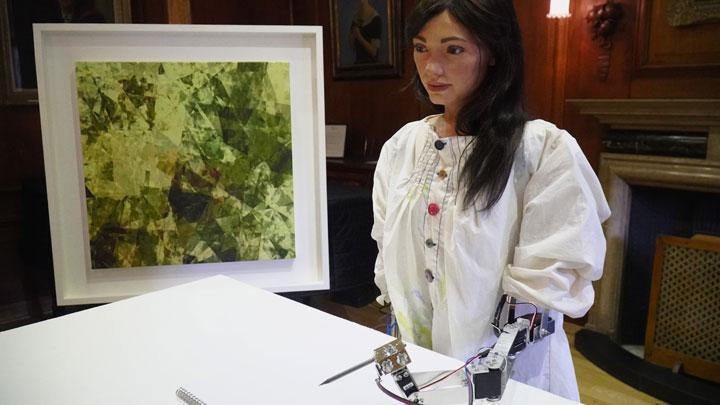
Robert Draws – Honoring a legacy, the works of the late Amang Rahman Jubair are once again on display for the public to appreciate at the Prabangkara Gallery in Surabaya. From February 27 to March 7, 2025, the exhibition “In Memoriam Amang Rahman Jubair & Ilham Jubair Baday” offers a unique opportunity to witness the artistic journey of two generations of artists. The event also marks the release of Amang’s book, Estetika Sufistik, further enriching the understanding of his artistic philosophy. Through this exhibition, viewers can immerse themselves in the depth and evolution of Amang Rahman’s powerful artistic expressions, alongside the promising works of his son, Ilham Jubair Baday.
The exhibition presents a collection of 20 paintings by both Amang Rahman Jubair and his son Ilham Jubair Baday. Although their works are displayed together, they are carefully arranged in separate sections of the gallery to honor each artist’s unique style. Amang’s works are featured in the left wing of the gallery’s second floor, while Ilham’s creations are placed in the right wing. This setup emphasizes the different artistic journeys of father and son, creating a visual dialogue between their works.
Ilham, the youngest of Amang’s four children, continues his father’s artistic legacy. His paintings, while modern in approach, reflect some of the themes and techniques explored by Amang. This exhibition provides an insightful look into how both artists share a common bond in their creative processes, yet also carve their own paths in the art world.
“Read about: Exploring Timeless Classical Painting Techniques That Still Resonate Today”
The paintings showcased from Amang Rahman Jubair span several decades, with works dating back to the 1960s and running through the 1990s. These pieces trace Amang’s artistic evolution, reflecting the phases of his career and his changing approach to art. Some of the most notable works include Undangan (1968), Bahtera Kehidupan (1970), Perjalanan Malam (1972), Lorong Waktu (1990), Impresi Gerhana (1995), Sebuah Lagu (1996), and Bukit di Cangar (1997). These works highlight his skillful use of surrealism and symbolism, which marked his distinct style as an artist deeply connected to both spiritual and worldly themes.
Additionally, several exhibition posters from Amang’s past solo shows are displayed as part of the tribute. These posters represent significant moments in his career, including exhibitions held at the prestigious Taman Ismail Marzuki (TIM) Jakarta in 1984, the French Cultural Center in 1987, and Bentara Budaya Jakarta in 1990. These visual artifacts showcase his prominent role in the Indonesian art scene, with each exhibition contributing to his growing reputation as a leading figure in Surrealism.
“Read more: G-Dragon Bigbang New Album Successfully Records Impressive Achievements”
Yunus Jubair, the exhibition organizer and Amang’s second son, explained that the exhibition demonstrates the long and consistent process of becoming an artist. He emphasized that a true artist must stay committed to their craft and explore literature, thought, and expression through their works. According to Yunus, Amang’s dedication to maintaining a consistent artistic practice reflected in his habit of setting exhibition goals, aiming for a solo show every two years. This ensured that his creative spirit remained active and thriving.
Yunus fondly remembers his father as an artist who did not compromise his ideals for commercial gain. Amang believed in positioning his work according to art’s true value and turned down lucrative offers that sought to commercialize his art. Yunus shared an anecdote about a potential exhibition offered to Amang at a national bank’s launch event in Kuningan, Jakarta. Despite the sponsorship guaranteeing the sale of many paintings, Amang rejected the offer. He chose instead to show his work at Taman Ismail Marzuki, where he felt the environment would align better with his artistic values.
Amang’s artistic legacy is defined by prominent figures like Gus Dur, WS Rendra, and Arfin C. Noor collecting his works. Yunus shared that Amang found fulfillment in knowing that people who understood its depth appreciated his art. Despite commercial opportunities, Amang remained steadfast in believing that people should revere art for its cultural and emotional impact.
Yunus recalls how his father never boasted about his success. Many collectors sought Amang’s paintings, but he did not always sell them. At times, offers of hundreds of millions of rupiah came for his work, but Amang chose to keep some pieces for himself. He understood their deep personal significance. Through dedication to his art, Amang provided his family with stability, allowing them to live comfortably in Surabaya.
Amang’s close friend, Hotman Siahaan, noted that Amang mastered Surrealism. His art often blended spiritualism with introspection. Hotman believes Amang’s influence on the Surabaya art scene will inspire future generations. Amang’s works, rich in symbolism, reflect his deep understanding of the connection between humanity and the divine.